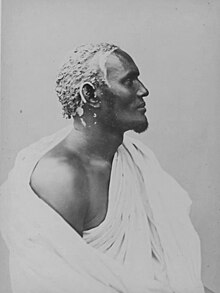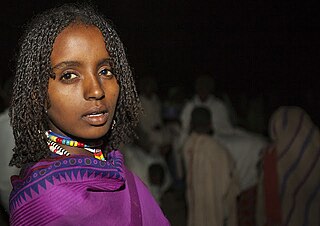
The Oromo people are a Cushitic ethnic group native to the Oromia region of Ethiopia and parts of Northern Kenya. They speak the Oromo language, which is part of the Cushitic branch of the Afroasiatic language family. They are one of the largest ethnic groups in Ethiopia. According to the last Ethiopian census of 2007, the Oromo numbered 25,488,344 people or 34.5% of the Ethiopian population. Recent estimates have the Oromo comprising 45,000,000 people, or 35.8% of the total Ethiopian population estimated at 116,000,000.

Somalia, officially the Federal Republic of Somalia, is the easternmost country in continental Africa. The country is on the Horn of Africa and is bordered by Ethiopia to the west, Djibouti to the northwest, the Gulf of Aden to the north, the Indian Ocean to the east, and Kenya to the southwest. Somalia has the longest coastline on Africa's mainland. Somalia has an estimated population of around 17.1 million, of which over 2 million live in the capital and largest city Mogadishu. Around 85% of its residents are ethnic Somalis. The official languages of Somalia are Somali and Arabic, though the former is the primary language. The people of Somalia are Muslims, the majority of them Sunni.
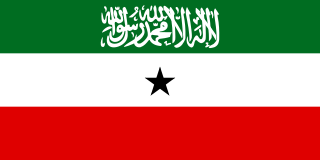
Somaliland, officially the Republic of Somaliland, is an unrecognised country in the Horn of Africa, recognised internationally as de jure part of Somalia. It is located in the southern coast of the Gulf of Aden and bordered by Djibouti to the northwest, Ethiopia to the south and west, and Somalia to the east. Its claimed territory has an area of 176,120 square kilometres (68,000 sq mi), with approximately 6.2 million residents as of 2024. The capital and largest city is Hargeisa. The Government of Somaliland regards itself as the successor state to British Somaliland, which, as the briefly independent State of Somaliland, united from 1960 to 1991 with the Trust Territory of Somaliland to form the Somali Republic.

The Horn of Africa (HoA), also known as the Somali Peninsula, is a large peninsula and geopolitical region in East Africa. Located on the easternmost part of the African mainland, it is the fourth largest peninsula in the world. It is composed of Somalia, Djibouti, Ethiopia, Eritrea and Somaliland. Although not common, broader definitions also include parts or all of Kenya and Sudan. It has been described as a region of great geopolitical and strategic importance since it is situated along the southern boundary of the Red Sea, extending hundreds of kilometres into the Gulf of Aden, Guardafui Channel, and Indian Ocean, it also shares a maritime border with the Arabian Peninsula.

Marodi Jeh is an administrative region (gobol) in western Somaliland. It is the most populous region of the country. It is bordered by Awdal to the west, Sahil to the north, Togdheer to the east and Ethiopia to the south. Marodi Jeh was created by splitting the previously existing region (gobolka) In 2007 the region of Woqooyi Galbeed was renamed to Maroodi Jeex.
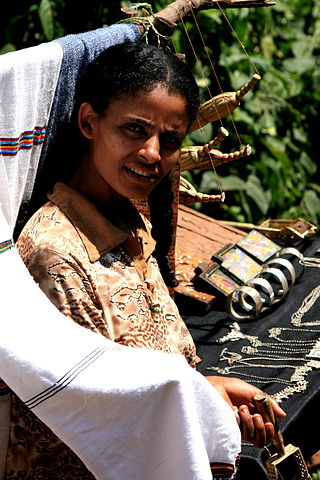
Amharas are a Semitic-speaking ethnic group which is indigenous to Ethiopia, traditionally inhabiting parts of the northwest Highlands of Ethiopia, particularly inhabiting the Amhara Region. According to the 2007 national census, Amharas numbered 19,867,817 individuals, comprising 26.9% of Ethiopia's population, and they are mostly Oriental Orthodox Christian.

Ogaden is one of the historical names used for the modern Somali Region which forms the eastern portion of Ethiopia and borders Somalia. Other names sometimes used for this area are Haud or Hawd.

The Somali people are a Cushitic ethnic group native to the Horn of Africa who share a common ancestry, culture and history. The Lowland East Cushitic Somali language is the shared mother tongue of ethnic Somalis, which is part of the Cushitic branch of the Afroasiatic language family, and they are predominantly Sunni Muslim. Forming one of the largest ethnic groups on the continent, they cover one of the most expansive landmasses by a single ethnic group in Africa.
The Dir is one of the largest and most prominent Somali clans in the Horn of Africa. They are also considered to be the oldest Somali stock to have inhabited the region. Its members inhabit Djibouti, Somalia, Ethiopia, and northeastern Kenya.
The Yibir, also referred to as the Yibbir, the Yebir, or the Yibro, are a caste of Somali people. They have traditionally been endogamous. Their hereditary occupations have been magic making, leather work, the dispensing of traditional medicine and the making of amulets. They belong to the Sab clan and sometimes referred to as a minority clan, they perform menial tasks.
Caste systems in Africa are a form of social stratification found in numerous ethnic groups, found in over fifteen countries, particularly in the Sahel, West Africa, and North Africa. These caste systems feature endogamy, hierarchical status, inherited occupation, membership by birth, pollution concepts and restraints on commensality.
Zhao Rukuo, also romanised as Zhao Rugua, Chau Ju-kua, or misread as Zhao Rushi, was a Chinese government official and writer during the Song dynasty. He wrote a two-volume book titled Zhu Fan Zhi. The book deals with the world known to the Chinese in the twelfth and thirteenth centuries; the first volume is a list of foreign places with descriptions of each place and the customs of its local people. The second volume is a catalog of trade goods.

Somali mythology covers the beliefs, myths, legends and folk tales circulating in Somali society that were passed down to new generations in a timeline spanning several millennia in Somalia and Djibouti dating back 6000 years ago. Many of the things that constitute monotheistic Somali mythology today are traditions whose accuracy have faded away with time or have been gentrified considerably with the coming of Islam to the Horn of Africa.
The Weyto are a caste living in the Amhara region along the shore of Lake Tana in northern Ethiopia. They worship the Nile River. They currently live in Bahir Dar, Abirgha, Dembiya and Alefa. The Weyto also made up part of the population of the Blue Nile Falls and Fogera, where currently their presence has not been ascertained.

Somali nationalism is a nationalist ideology advocating for the unification of all Somali people who share a common ethnicity, language, and culture, under a single banner. Its earliest manifestations has its roots in the Middle Ages and the Adal Sultanate whilst in the contemporary era its often traced back to the Somali Youth League, a political organisation founded in 1943. The Somali Youth League became one of the most influential political parties in Somalia prior to post-independence. The Somali guerilla militia Al-Shabab is also noteworthy for incorporating Somali nationalism into its Islamist ideology.
Garad is a term used to refer to a king, Sultan or regional administrator. It was used primarily by Muslims in the Horn of Africa that were associated with Islamic states, most notably the Adal Sultanate.
Yusuf bin Ahmad al-Kawneyn, popularly known as Aw Barkhadle or Yusuf Al Kownayn, was an Islamic scholar and traveler based in Zeila. Based on reference to Yusuf Al Kawneyn in the Harar manuscripts, Dr. Enrico Cerulli.
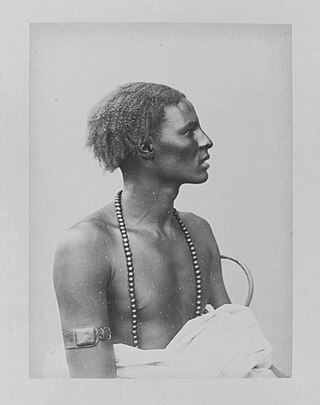
The Tomal, also known as Tumal or Tumaal, is an artisanal caste among Somali people. Their traditional hereditary occupation has been as smiths and leather production, and they have been endogamous.

The Isaaq Sultanate was a Somali kingdom that ruled parts of the Horn of Africa during the 18th and 19th centuries. It spanned the territories of the Isaaq clan in modern-day Somaliland and Ethiopia. The sultanate was governed by the Rer Guled branch of the Garhajis clan and is the pre-colonial predecessor to the modern Republic of Somaliland.
The Abaskuul, Abasguul, Abasgul or Abaskul is a Somali sub-clan of the Jidwaaq, Absame, Kumade, Kablalah, Darod line. The Abaskuul mainly reside between Jigjiga and Degahbur in the Somali Region in Ethiopia, but also have settlements in Jubaland (Somalia) and Kenya. They share borders with the Ogaden, Bartire, and Habar Awal clans. The Abaskuul were famously described in Richard Burton's First Footsteps in East Africa, as well as 17 Trips to Somaliland and a Visit to Abyssinia by Captain Harald G. C. Swayne.
